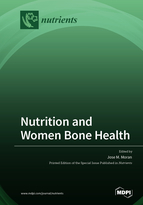Nutrition and Women Bone Health
A special issue of Nutrients (ISSN 2072-6643). This special issue belongs to the section "Nutrition in Women".
Deadline for manuscript submissions: closed (18 November 2021) | Viewed by 28711
Special Issue Editor
Interests: genetics of bone density; nutrition and women bone health; polyunsaturated fatty acid intake and women bone health
Special Issues, Collections and Topics in MDPI journals
Special Issue Information
Dear Colleagues,
The aim of this Special Issue "Nutrition and Women Bone Health" is to focus on the relevance of nutrition as a key element that has the potential to reduce bone loss or fracture risk.
Specifically, the objective is to bring to the body knowledge about the role that intake of certain nutrients such as calcium, vitamin D, proteins, vitamins, minerals or polyunsaturated fatty acid may have on the bone health of women at different stages of life. The impact that these and other nutrients may have on the progression of different diseases and their relationship to women's bone health will also be of interest.
Studies that deepen the understanding of the relationship between genetics and nutrient intake are especially welcome in the context of women's bone health.
In this Special Issue, we aim to address these fascinating areas, which are the major ongoing challenges in women's bone health research and practice.
Prof. Dr. Jose M. Moran
Guest Editor
Manuscript Submission Information
Manuscripts should be submitted online at www.mdpi.com by registering and logging in to this website. Once you are registered, click here to go to the submission form. Manuscripts can be submitted until the deadline. All submissions that pass pre-check are peer-reviewed. Accepted papers will be published continuously in the journal (as soon as accepted) and will be listed together on the special issue website. Research articles, review articles as well as short communications are invited. For planned papers, a title and short abstract (about 100 words) can be sent to the Editorial Office for announcement on this website.
Submitted manuscripts should not have been published previously, nor be under consideration for publication elsewhere (except conference proceedings papers). All manuscripts are thoroughly refereed through a single-blind peer-review process. A guide for authors and other relevant information for submission of manuscripts is available on the Instructions for Authors page. Nutrients is an international peer-reviewed open access semimonthly journal published by MDPI.
Please visit the Instructions for Authors page before submitting a manuscript. The Article Processing Charge (APC) for publication in this open access journal is 2900 CHF (Swiss Francs). Submitted papers should be well formatted and use good English. Authors may use MDPI's English editing service prior to publication or during author revisions.
Keywords
- Nutrigenetics
- Women’s health
- Bone mineral density
- Diet
- Fracture
- Menopause
- Osteoporosis
- Calcium
- Dairy
- Protein intake
- Vitamin D







